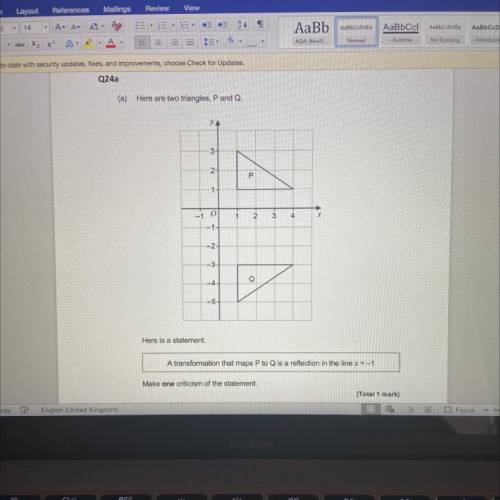Help.
Gcse foundation.
...

Answers: 3


Another question on Mathematics

Mathematics, 21.06.2019 20:30
Answer asap ill give ! ’ a sample of radioactive material decays over time. the number of grams, y , of the material remaining x days after the sample is discovered is given by the equation y = 10(0.5)^x. what does the number 10 represents in the equation? a. the half-life of the radioactive material, in days b. the amount of the sample, in grams, that decays each day c. the time, in days, it will take for the samples to decay completely d. the size of the sample, in grams, at the time the material was discovered
Answers: 1

Mathematics, 21.06.2019 22:20
The figure shows triangle def and line segment bc, which is parallel to ef: triangle def has a point b on side de and point c on side df. the line bc is parallel to the line ef. part a: is triangle def similar to triangle dbc? explain using what you know about triangle similarity. part b: which line segment on triangle dbc corresponds to line segment ef? explain your answer. part c: which angle on triangle dbc corresponds to angle f? explain your answer. asap
Answers: 3

Mathematics, 22.06.2019 02:00
Study published in the journal of personality and individual differences found that adults with adhd displayed more creative achievement than those who didn't have the disorder. "for the same reason that adhd might create problems, like distraction, it can also allow an openness to new ideas," says holly white, assistant professor of cognitive psychology. "not being completely focused on a task lets the mind make associations that might not have happened otherwise." white and priti shah at the university of michigan gave 60 college students – half of them with adhd – a series of tests measuring creativity across 10 domains. the adhd group scored higher across the board. the adhd group showed more of a preference for brainstorming and generating ideas than the non-adhd group, which preferred refining and clarifying ideas. the adhd status of the participants was established by asking whether the individual had ever been clinically diagnosed with adhd/add. the tests of creativity were pencil-and-paper tasks administered in a laboratory setting. each of the ten scales was comprised of multiple questions, the scores on which were summed (e.g., writing creativity: "how many words can you make from the letters in the word 'psychology' invention creativity: "write down as many uses for a paper clip that you can think of.") this procedure does allow for a participant to be scored as showing no creativity under these conditions. a) state the research question in plain language (i wonder if is related to (1 point) b) state the null hypothesis (1 point) c) state the research hypothesis (1 point) d) is the research hypothesis directional or non-directional (1 point) e) name the predictor / independent variable f) give the operational definition of the predictor / independent variable g) evaluate the construct validity of the predictor / independent variable. (face, procedure, method-match) h) name the outcome / dependent variable i) give the operational definition of the outcome / dependent variable. j) evaluate the construct validity of the outcome / dependent variable. (face, procedure, method-match)
Answers: 1

Mathematics, 22.06.2019 04:20
How many dollars more is the price of a pie than the price of a doughnut at erik’s store
Answers: 3
You know the right answer?
Questions

Mathematics, 16.07.2020 19:01



History, 16.07.2020 19:01





Mathematics, 16.07.2020 19:01




English, 16.07.2020 19:01


Mathematics, 16.07.2020 19:01



Mathematics, 16.07.2020 19:01






